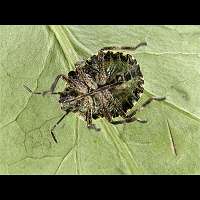Raphigaster nebulosa
The larvae of shield bugs often are quite difficult to identify. They don't look much like their parents, but often resemble ones from other species. And what's more: after each moulding many of them change their colour and thus their appearance. So we are very glad Dr. Wolfgang Rabitsch was able to tell us the name of the species below. It is highly probable this is a larva of Raphigaster nebulosa, a species without common English name. The adults do look like Troilus luridus a lot. Reaching a length of 14 to 16 mm., they are bigger though. Besides their antennae have two yellow bands. In the larvae these bands are not visible. Raphigaster nebulosa too sucks on both: plants and other insects. Is often found sucking on hazles, sometimes becoming a pest when appearing in great numbers. This is a species of woodlands mainly, but it is also seen on walls of houses and sheds. Sometimes found indoors in autumn, seeking a place to overwinter. Raphigaster nebulosa likes to overwinter on ivy-clad walls, fences and trees. A common species in most parts of Europe, but not present in the northern areas. We do not know anything about its presence in the UK and Ireland.
The larvae of shield bugs often are quite difficult to identify. They don't look much like their parents, but often resemble ones from other species. And what's more: after each moulding many of them change their colour and thus their appearance. So we are very glad Dr. Wolfgang Rabitsch was able to tell us the name of the species below. It is highly probable this is a larva of Raphigaster nebulosa, a species without common English name. The adults do look like Troilus luridus a lot. Reaching a length of 14 to 16 mm., they are bigger though. Besides their antennae have two yellow bands. In the larvae these bands are not visible. Raphigaster nebulosa too sucks on both: plants and other insects. Is often found sucking on hazles, sometimes becoming a pest when appearing in great numbers. This is a species of woodlands mainly, but it is also seen on walls of houses and sheds. Sometimes found indoors in autumn, seeking a place to overwinter. Raphigaster nebulosa likes to overwinter on ivy-clad walls, fences and trees. A common species in most parts of Europe, but not present in the northern areas. We do not know anything about its presence in the UK and Ireland.





